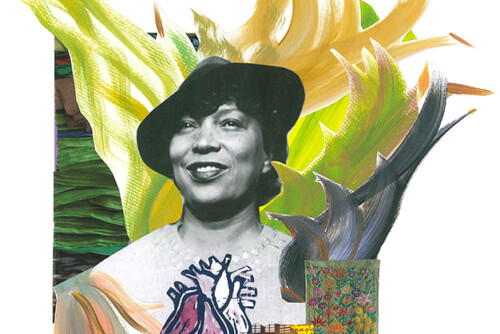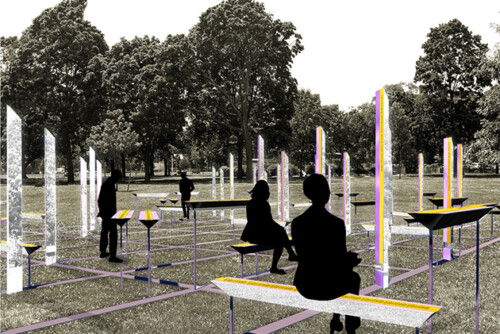Public Access and Representation
Since the 1969 Stonewall rebellion, the Christopher Street area in New York City has been identified with queer life. Over the past decades, the Christopher Street Pier as well as the street itself have become collective public gathering places for queer youth of color especially. But over those decades, the surrounding West Village has gentrified, and increasingly wealthy property owners often see the streets as their private space. Low-income queer youth of color have been increasingly marginalized as local property owners have pressured police and community boards to restrict uses of the pier as well as the streets. Such pressure has resulted in an increased policing of queer youth of color in the neighborhood and a shift in the services offered there. Intake centers for emergency shelters have been moved to outer boroughs, funding for mobile units parked in the neighborhood has been cut, and policing has been intensified.1 Despite its history as a queer social movement center, the entire Christopher Street area has erased that democratic, public history as the forces of gentrification have created a whiter, wealthier neighborhood in which queer youth of color are less and less welcome.
Conclusion
The funding streams for government services and nonprofit organizations generally support and encourage programs that deliver services to individuals who need services as a result of individual problems or pathologies (drug use, trauma, depression). This politically conservative model of social service provision neglects or denies the systemic and structural causes of collective need for resources. Accountability to LGBTQQ youth is also missing from this traditional structure of social services. Services and advocacy priorities are often set by professionals working with homeless youth and do not come from the experiences of young people. In general, there is a disconnect between homeless youth and the organizations, foundations, and agencies providing services.
Mainstream LGBTQQ organizations do not recognize the major issues created for queer youth by this model of individualized service provision. Many organizations are silent on issues of class, race, and the intersections of oppression. A falsely unified gay identity is often portrayed, rendering multiple identities and forms of oppression as relatively invisible on the mainstream “gay agenda.”
Nevertheless, there is increasing change happening at the local level. Remarkably, the organizing work of local service providers has affected change in more immediate ways than the national organizations whose missions are supported by millions of our community’s dollars. Local grassroots organizations and progressive service providers targeting LGBTQQ low-income and homeless youth are addressing the needs of these young people in a unique way. There is increasing attention being put on the high prevalence of trauma experienced by homeless youth. There is ample evidence that homeless youth are exposed to and experience high rates of family and community violence. This understanding is now informing the ways in which services are being provided to this community. For many youth, these traumatic experiences shape their core identity and behaviors with adults. The consequences of trauma exposure interfere with a young person’s ability to engage in and benefit from services designed to promote stability and improve their quality of life. A trauma-informed approach attempts reduce barriers to engagement and enable young people to create realistic plans to increase their stability and achieve personal goals. Homeless young people responding to trauma frequently exhibit disruptive or challenging behaviors and often get restricted from the programs that are designed to serve them. Successful youth-serving agencies use an approach that promotes healthy attachment, self-regulation, and developmental skill competencies. Trauma-informed work also creates a response to conflict or disruptive events that focuses on the needs of the people involved instead of the need to satisfy the abstract principles of law or the need of the agency to exact punishment. Young people are given an active role in a dispute and young people who exhibit difficult behavior are encouraged to take responsibility for their actions and are asked to work towards repairing the harm they have done.
Locally, there are also a number of LGBTQ organizations that have shifted the way in which social services to LGBTQ youth are provided. Traditionally, the voices of LGBTQ youth were not included in advocacy efforts. Adults and professionals working on behalf of young people set the policy and service priorities. In New York, organizations like FIERCE!, SRLP, and Streetwise and Safe (SAS), among others, have transformed the way youth participate in organizing and advocacy efforts. These organizations have created opportunities for lawyers and organizers to share information with youth and provided guidance and support for the youth to create tools to educate and share information with their peers. For example, SAS works with LGBTQ youth of color around policing issues in NYC. Lawyers and organizers engage a group of youth who have direct experience with the criminal justice system in a semester-long program. Together they exchange information about the legal system and police practices, and work to develop a “know your rights” curriculum that the youth can share with their peers. This youth development approach to social and legal services is an important component to any youth services program that seeks to empower young people to participate in the political process.
Together, such organizations are part of a larger social justice movement addressing systemic inequalities that include sexual and gender oppression.2 There are grassroots efforts to not only improve the lives of low-income LGBTQQ individuals, but to create authentic leadership among the most vulnerable members of the community. Organizations are also looking inward. There are a number of local grassroots organizations that are rethinking the traditional nonprofit and social service models. They are creating models where transparency and accountability are valued. They are breaking down traditional hierarchical models and replacing them with transparent decision-making processes or collective models. They are committed to a world where all people have access to life’s basic needs, where all are empowered to make change, and where everyone is able to live and love freely and safely. Together, we are working hard to change the landscape.
- FIERCE, White Paper: Expanding Access to Public Space at the Hudson River Park (New York: FIERCE, 2009). [↩]
- New York State Office of Children and Family Services, Runaway and Homeless Youth Annual Report (New York: New York State Office of Children and Family Services, 2010). [↩]




